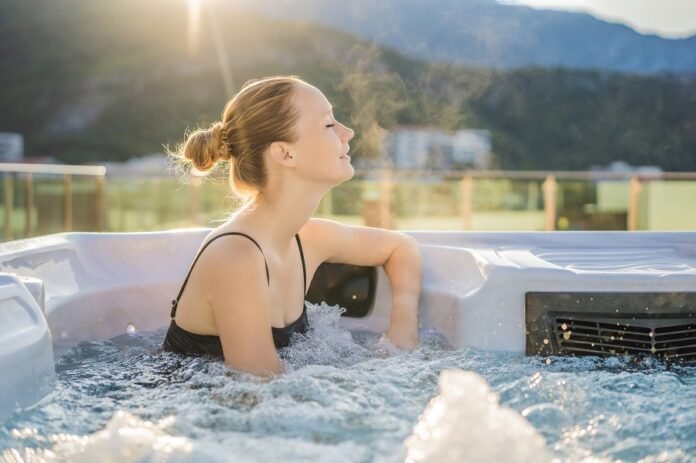Home spas are believed to relieve stress and improve sleep quality. They are also easy to access and can even increase the appeal of your home. However, adding a spa to your home requires a significant investment. And depending on the type of home spa you install; it would also require a high level of care and maintenance.
Fortunately, choosing an above-ground spa is more cost-efficient than an in-ground spa. So, if you want to add a home spa without breaking the bank, choosing to install an above-ground spa is a good decision. But aside from being cost-efficient, there’s a lot more you should know about above-ground spas. Read on for more information.
What Are The Benefits Of Above-Ground Spas?
As most people know, Australian made above ground spas come with benefits. Among these benefits include:
- Stress Relief
The first benefit of a home spa is its ability to lower stress levels. The effect of warm, soothing water and the massaging aspect releases physical, mental, and emotional tension. For even better results, consider incorporating slow music during the bath.
- Improve Skin Health
Home spas are well known for their anti-aging effects. People regularly soaking in hot spas will likely experience a natural glow and skin firmness. The result is even more visible if you add minerals and exfoliating treatment to the water. Therefore, if you’re looking forward to maintaining young-looking skin, consider investing in an above ground spa.
- Improves Sleep Quality
Do you struggle to fall or stay asleep? If yes, your ideal remedy might be a spa. Spa jets provide detailed massage, especially in stiff, uncomfortable areas. With an improved blood flow, excellent heart rate, and relaxed muscles, what can stand between you and a night of good sleep?
- Enhanced Blood Circulation
Spa jets release heat believed to improve blood flow and soothe the tissues surrounding arthritic joints. As a result, you experience reduced stiffness and inflammation. Spas also reduce muscle pains and injuries since the warm therapeutic water enables the blood to maneuver through affected areas.
Additionally, the heat from spa jets improves blood circulation by dilating blood vessels resulting in a healthy heart. Generally, individuals with cardiovascular disorders can benefit a lot from hot spas.

Advantages Of Above Ground Spa
There are two major types of spas on the market. Aside from the above ground spa, there’s also the in-ground type. Each spa comes with advantages and disadvantages. Here are some benefits associated with above ground spas:
- Seamless Installation
Unlike in-ground spas, above ground spas don’t require digging and leveling. This means an above ground spa doesn’t interfere with your yard integrity and doesn’t leave marks after relocation. Therefore, they’re easier and less expensive to install.
- Low-Maintenance
As the name suggests, above-ground spas are elevated and don’t come into contact with the ground. For this reason, these pools are less likely to get dirty or have insects and pests access their interior. Above-ground spas are also smaller; cleaning them requires little time. You can also invest in covers to protect your spa from various elements and minimize the amount of dirt.
- It’s Portable
Another pro of investing in an above-ground spa is its portability. This spa can be removed and transported easily. Therefore, you can always move it within your yard or transport it to another property if you want to.
- It’s Cost-Effective
The difference between the cost of purchasing and operating an above-ground and in-ground spa is quite significant. It can add up to thousands of dollars. Besides the purchasing price, the materials and labor involved are cheap and not taxed since they aren’t permanent structures. Whether or not you consider adding fixtures, the general cost of an above-ground spa will still be low compared to an in-ground one.
- They’re Safer
Many above-ground spas are either 48 or 52 inches deep. Therefore, they’re shallower than in-built. Above-ground spas are also safe since they have an all-around handle to prevent slippage. Therefore, these spas are safer since kids and pets are unlikely to slip in due to their elevated nature.
Cons Of Inbuilt Spas
Above-ground spas also have a few disadvantages, such as:
- They Are Not Aesthetically Appealing
Above-ground spas aren’t aesthetically pleasing as their in-ground counterparts. Some people would even refer to them as enhanced kiddie pools. Though you can improve their appearance by surrounding them with flowers and other decorations, you can’t compare them to in-ground spas regarding aesthetics.
- They’re Easily Damaged
On average, above-ground spas can last up to 15 years. However, with proper maintenance, they can last longer. Unfortunately, even with proper maintenance, in-ground spas still have a longer life span. Furthermore, above-ground spas can be easily damaged by severe weather like storms and snow.
- They Are Not Versatile
Above ground spas come in limited designs. Generally, you cannot customize them with lights and other fixtures, unlike the in-ground type. Customization is only limited to the surrounding areas of the spa itself.
- They Do Not Add Property Value
Suppose you’re planning on selling your property and hope an above ground spa can positively impact the price. In that case, you’re in for a shock. While water features are known to increase property value, above ground spas are most likely the exception. These spas aren’t aesthetically appealing, smaller, and are easily damaged.
For these reasons, most property buyers are unlikely to view them positively, let alone pay more for them. Therefore, if you’re looking forward to increasing your home’s value, an in-ground spa might be a better choice.
- They’re Challenging To Enter
Unlike in-ground spas, you must lift your legs to enter an above-ground spa. These spas are unideal for seniors or people with health conditions preventing them from raising their feet.
How To Set Up An Above-Ground Spa
As earlier stated, setting up an above-ground spa is simple. If you’re planning on doing so, here are steps to follow:
- Clear The Area
After ordering the tub, it will be delivered to your home. After the arrival, they’ll position the tub on its side on a cart and move it into your backyard. This means that the area must be accessible and free of debris for easier movement.
Accessibility is vital; hence you must ensure you can access the equipment panel. This is among the most crucial parts of a spa, and you might experience difficulty installing the tub if the panel is inaccessible.
It’s important to ensure the tub isn’t within ten feet of overhead power lines. This is because water plus electricity can lead to severe accidents that might be fatal.
- Ensure The Ground Is Stable
You don’t want your above ground spa to sink into the ground. It’s, therefore, vital to find a stable base since portable spas are heavy and can sink quickly on unstable ground. Even if the spa doesn’t sink, it’ll likely remain unstable if the foundation isn’t solid.
Experts advise installing above ground spas on flat concrete ground. You can also install it on your deck since the ground can hold the spa and occupants’ weight. Nevertheless, installing a spa on a concrete pad isn’t a must. You can still install it on level stone pavers. Other alternatives include composite slabs made from gravel, wood, or heavy-duty plastic.
- Understand Electrical Requirements
Be mindful of the electrical needs of your chosen tub. However, most hot tubs require 110V or 220V. A spa requiring 110V is also called ‘plug and play’ since you can plug it into a typical electrical outlet. Upon installation, you’ll need a professional electrician’s help. They’ll ensure the wiring is done correctly and the spa receives enough power.
- Fill The Spa And Enjoy
At this moment, nothing is standing between you and a perfect soak. An above ground spa doesn’t require exceptional plumbing since it’s self-contained. Once you’re done installing it, the only thing left is filling it and enjoying yourself. You can quickly fill your above ground spa with a garden horse.
How To Care For An Above-Ground Spa
Maintaining an above ground spa is not that difficult. It only involves testing the water balance at least twice a week and adjusting it with the correct chemicals. You should also clean the filters at least once a week and replace them annually. The spa drain should always be clean, and it should be refilled after three to four months. Remember to air out the spa cover twice a week.
Conclusion
From its name, above ground spas are installed over the ground. For this reason, the installation procedure is easier and less costly than building an in-ground spa. Like any other spa, above ground spas have several health benefits, including lowered stress levels, improved heart health and sleep quality, and enhanced skin tone.
Nevertheless, above ground spas also have disadvantages. For one, it may not essentially increase the value of your property. They’re also limited in design and can be easily damaged. If you’re planning on investing in above ground spas, consider the advantages, benefits, and disadvantages before deciding.


























